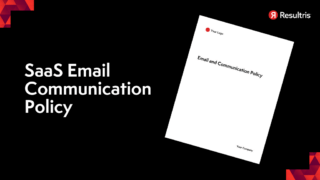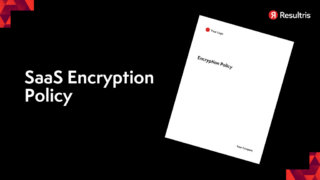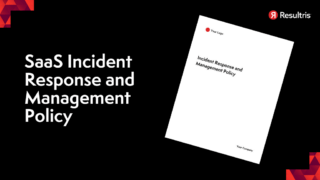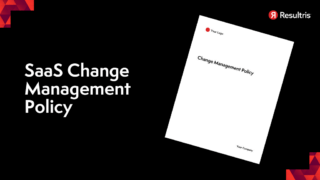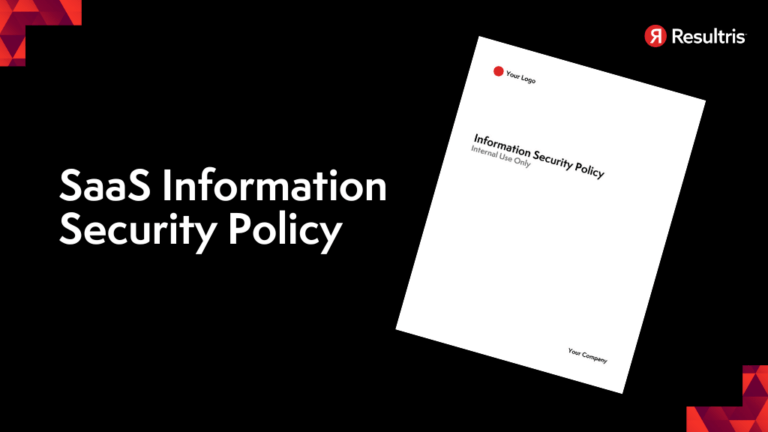
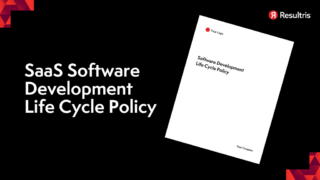
Written by: Tim Eisenhauer
Last updated:

Securing your software assets has never been more critical. If you’re navigating the world of Software as a Service (SaaS), you’re no stranger to its complexities, especially regarding information security.
With the rise of cyber threats, it’s essential to have a robust SaaS Information Security Policy in place. This policy safeguards your data and ensures you’re compliant with relevant regulations.
To help you stay ahead, we’ll delve into SaaS Compliance and Security Best Practices in this article. We’ll guide you through crafting a comprehensive policy that works for your business. Stay tuned for a deep dive into the world of SaaS security.
Unraveling SaaS Information Security Policies requires understanding the key components and their importance in creating robust SaaS environments.
A SaaS Information Security Policy delivers guidelines for protecting software services online. It’s a digital map that guides a company’s data defense mechanisms. Think of it as a protective shield providing a safe harbor for your precious information amidst the vast cloud space.
In its essence, a SaaS security policy incorporates preventive, detective, and reactive measures. An effective policy includes data encryption, strong authentication measures, such as multi-factor authentication, intrusion detection systems, and a rapid response protocol to mitigate the impact of security incidents.
Why does it matter? It brings several advantages to the table. It helps safeguard sensitive data, ensures business continuity in the face of cyber threats, and promotes customer trust—let’s not forget, reputation can make or break a SaaS company. Moreover, a comprehensive security policy ensures you stan laws and regulations, leading the industry.
Compliance isn’t just for show—it’s a crucial part of SaaS data security. Navigating the world of regulations can be tricky, but it’s necessary.
Among the legion of regulations, GDPR and CCPA are two significant ones. GDPR stands for the General Data Protection Regulation, reigning over Europe, with CCPA, the California Consumer Privacy Act, overlooking the golden state. These regulations enforce strict data protection practices and violators might find themselves in deep waters.
Certain industries come with their unique set of rules—HIPAA for healthcare, PCI DSS for finance, and so on. These industry-specific requirements add another layer of complexity, but adhering to them is non-negotiable.
Cyber threats are like unwanted guests—they show up uninvited! Top contenders include data breaches, account hijacking, and insider threats. Advanced persistent threats (APTs) that loiter in the system undetected for a long time, siphoning off data, also pose a major concern. Adopting a resilient IT security policy helps guard against these unwelcome digital intruders.
Crafting an exceptional SaaS Information Security Policy demands proper steps. An initial assessment is crucial for understanding where your security stands and the scope of enhancement. From there, designing certain critical components and allotting them appropriately will enhance your policy’s grasp.
Start with an evaluation of your current security front, an essential step that fosters understanding of your business’s specific needs. Know your SaaS platform in and out, embodying aspects such as user data handling, application security measures, and data encryption techniques. Also, consider regulatory compliance, like GDPR, CCPA, HIPAA, and PCI DSS, that matter to your business. A thorough inquiry into these elements can highlight your weak links and areas where fortification is necessary.
An inclusive SaaS security policy mandates tight control over who can access your system. Use methods like multi-factor authentication and fine-grained permissions to limit access to only qualified individuals. Such measures prove instrumental in keeping your systems and data secure.
Another essential component of a SaaS Information Security Policy is data protection. Encrypting data whether at rest or in transit should be a mandate, not an option. It lessens the risk of sensitive business or customer data falling into wrong hands. Implement standard encryption techniques for robust data protection.
Safeguarding your network is vital to the soundhealth of your SaaS platform. Regular monitoring for anomalies, firewalls, and intrusion detection systems are vital to maintain a robust network security framework.
With the rise in integration of third-party services in SaaS platforms, it’s pivotal to consider their impact on your security landscape. Vet them rigorously and ensure their compliance with your security standards, hence reducing third-party risks.
While SaaS primarily deals with the virtual world, never downplay the value of physical security measures. Server rooms should be secure, and any physical access to your systems should be strictly monitored and controlled.
Upon defining your IT security policy, it’s implementation becomes the pivotal point. Rolling it out across your organization mandates training your employees about the new rules and regulations. Moreover, enforcing the policy requires regular audits and a mechanism for handling violations when policies aren’t strictly adhered to.
Grasping the significance of various technical aspects optimizes the robustness of your SaaS Information Security Policy.
Cloud infrastructure security forms the heart of your SaaS security policy. It strictly safeguards all elements housed within your cloud environment. This security domain primarily tackles network protections, securing system boundaries, intrusion detection, and managing system vulnerabilities. To harden cloud infrastructure, implementation of firewalls counts as vital. It sets guards against unauthorized entries, blocking any suspicious or malicious activity. Intrusion detection systems (IDS) also play a pivotal role- they monitor network traffic, flagging potential threats. Regular system vulnerability assessments additionally can be beneficial, ensuring continual upgrades to security infrastructure.
Understand that your SaaS application isn’t just serving, but also storing hefty volumes of confidential data. Thus, application security sits at the top of your Information Security Policy priority list. Application security implies the procedures and strategies employed to thwart threats or attacks that might compromise your software application. This may include security requirements during app development, code reviews for security vulnerabilities, or use of security frameworks and libraries.
Data security and privacy, intrinsic cornerstones of IT security policy, warrant stringent measures. They manage encryption protocols, limit data access, and set up secure channels for data transfer. The principle of least privilege (PoLP) reigns supreme – assigning minimum data access levels needed, thus reducing the attack surface. Furthermore, ensuring advanced encryption standard during data storage and transmission endows your SaaS data security with an additional layer of protection.
APIs – application programming interfaces – often become the Achilles’ heel of your SaaS security policy. They provide gateways to manipulate or fetch data from your application. Therefore, placing security measures like enforcing secure API gateways, authentication and authorization checks, and rate limiting can prevent potential security breaches. Implementing routine API security audits sways advantage in your favor, spotlighting vulnerabilities, if any.
Taking a dive into the operational aspects of your SaaS Information Security Policy heightens your defense mechanism. It makes a substantial difference in how well your security plans perform.
Remember, it’s pivotal not to overlook this key element in your SaaS security policy. With the proper employee onboarding and training, you reduce the risk of unintentional breaches. Your teams become more aware of phishing scams, sketchy downloads, and sensitive data mishandling.
Making frequent audits a part of your cloud security policy ensures you’re ahead of breaches. Regular checks allow for the detection of any anomalies in the system’s behavior. Additionally, always keeping your software up to date wards off hackers who feast on obsolete systems.
Despite your best precautions, there’s no absolute guarantee against a breach in your information security policy. This is where incident response planning comes in.
An Incident Response Team (IRT) constitutes a group of IT professionals who, at the sign of any suspicious activity in your SaaS data security, quarks it down. An IRT is your first line of defense when a security incident happens.
It’s not just about having an Incident Response Team in your IT security policy. This team needs clear, concise procedures to follow. Thorough response procedures for each potential incident type allow your IRT to act quickly and efficiently.
Lastly, inevitable disasters shouldn’t spell doom for your business. Your SaaS Information security policy should include strategies to ensure business continuity and disaster recovery. This means developing plans that get your SaaS running again after an incident and restoring lost or compromised data swiftly.
Addressing legal and contractual aspects is pivotal to a well-rounded SaaS information security policy. It aids in defining the terms, conditions, and responsibilities that govern data security. Let’s dissect these areas further under two subheadings.
Crafting precise customer agreements and Service Level Agreements (SLAs) ties into your SaaS security policy’s success. Here, the emphasis lies in describing data management practices, delineating levels of access, and stating data breach notification procedures. For instance, mention how the data is stored, processed, and protected. Make it clear about the backup procedures, outlining frequency and retention periods.
Data access clarity in the SLAs fosters trust. Define who can access customer data and under what conditions. Also, enumerate the process if a security incident occurs – when and how the clients are notified.
In the context of SaaS data security, effective vendor management is essential. Identify and evaluate potential risks linked with vendors—primarily those who can access sensitive data. Regularly vet and audit these vendors to ascertain adherence to your IT security policy.
Vendor agreements should include clauses on information security measures followed at their end. Foster a culture of continuous improvement by periodically reviewing these measures. In case of a policy breach, create a plan, and define the repercussions.
Legal and contractual considerations underpin any robust SaaS security policy. Be it the clarity in customer agreements, or maintaining stringent vendor management—every element counts in fortifying your SaaS data security.
After detailing the different components of a robust SaaS Information Security Policy, let’s delve into how to measure its effectiveness. This section discusses the key security metrics for an IT security policy relevant to SaaS companies and the strategies for continuous improvement.
In understanding the effectiveness of your security policy, key security metrics serve as insightful gauges. These factors, embedded in the daily operations of SaaS companies, provide critical insight into the efficiency of security measures that have been put in place.
By monitoring these metrics, you’re not only assessing the performance of your SaaS security policy but also gaining valuable insights to tweak it for improvised cloud security.
Gaining insights from metrics is one part, translating those into effective measures for continuous improvement is another. Here are some strategies for achieving perpetual enhancement of your Information Security Policy:
Employing these strategies isn’t easy, but their inclusion in your SaaS data security can transform your firm’s stand against cyber threats drastically. Remember, reaching perfection isn’t the goal, rather it’s continuous improvement.
As the digital sphere continues evolving rapidly, so too, must your SaaS security policy. This section expands on the latest trends that are influencing SaaS Information Security strategies.
AI and Machine Learning, they’re not just buzzwords anymore. In the terrain of SaaS data security, they’re transforming the way threats are detected and resolved. These technologies analyze patterns in vast amounts of data, identifying anomalies that may represent security threats. It’s like having an automated sentry standing guard 24/7, spotting issues that the human eye might miss. The direct implication? Improved accuracy and faster incident response.
“If you’re not on the list, you’re not getting in.” That’s the essence of Zero Trust Architecture. This approach assumes that everything attempting to connect to your SaaS platform—be it an IP, a device, or a user—is a potential threat until verified. A stringent validation process undertaken for every connection, every time, regardless of its source, makes your cloud security policy more robust.
The integration of Development, Security, and Operations, collectively known as DevSecOps, is a significant game-changer. This approach embeds security throughout the software development lifecycle, rather than tacking it on at the end. From code commit to deployment, the focus is on delivering security at every step. The result? An IT security policy that’s iron-clad and a SaaS product that’s been protected from the get-go.
Think of your SaaS Information Security Policy as a living entity—not set in stone but ready to adapt and grow as necessary. These emerging trends in SaaS Information Security represent the next steps in your policy’s evolution. Fusing AI and Machine Learning with security, trusting no connections automatically, and injecting security into the development process—embracing these approaches can advance your security policy to meet the emerging threats in the digital world.
So you’ve seen the vast landscape of SaaS Information Security Policy. It’s clear that a robust policy isn’t just about securing your software assets. It’s about integrating advanced technologies like AI and Machine Learning for threat detection, adopting Zero Trust Architecture for rigorous validation, and embedding security in every step of your software development lifecycle with DevSecOps. It’s about being prepared, staying vigilant, and continuously evolving to outpace digital threats. Always remember, your security policy isn’t set in stone. It’s a living document that should grow and adapt with your business and the ever-changing digital world. So don’t just create a policy, nurture it, and let it guide you towards a safer, more secure SaaS environment.
Disclaimer
Please note that the information provided in this blog post is for informational purposes only and does not constitute legal advice. We are not lawyers, and reading this content does not create an attorney-client relationship. For legal advice specific to your situation, please consult with a qualified attorney.

